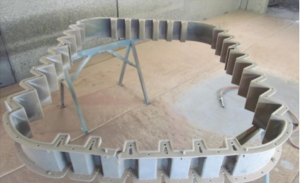Dry Abrasive Blast Cleaning
Dry abrasive blast cleaning uses compressed air to propel a stream of dry abrasive particles to impinge upon the surface to be cleaned. The impact of sharp angular particles striking at high speed creates a rough surface of many tiny peaks and valleys, providing an ideal foundation for phosphate pretreatment and for paint and coatings to adhere to.
Media blasting is preferred for removing heavy surface materials such as mill scale and paint on large surfaces. Blasting is also standard surface preparation for paint and coatings. The process is popular even though it affects surface finish, can damage thin parts, work hardens some surfaces, and does not remove oil, grease, fluid residues or chemical salts.
After blasting, a short time frame exists within which paints, coatings or pretreatment processes can be applied before flash rust develops or the surface becomes recontaminated.
Substrates
Most metals can be media blasted: Ferrous and carbon steels, cast iron, stainless steel, aluminum, alloys, titanium, bronze, copper, pot metals, etc. Non-metals including fiberglass, plastics, wood and stone can also be blasted. Base coatings such as powder coat, anodizing, fiberglass gel coats and fillers can be removed or left intact. Some plastics and fillers will be lightly etched. Thin materials, however, may not be suitable for blasting as the process can change dimensional tolerances or remove more substrate than desirable.
Surface Preparation Standards
Most blast cleaning standards or surface cleanliness – NACE, SSPC, ISO, etc. – reference visual appearance only. Additional specifications may be required to address other parameters including profile characteristics or non-visible contaminants such as oils, soluble salts, chemicals, etc.
Redi Strip ensures all work performed is in compliance with the Surface Preparation Standards of certifying bodies such as NACE, SSPC and ISO.
Abrasive Blast Media
The type of abrasive media selected depends on the application (cleaning, stripping, etching, strengthening or polishing, etc). Other factors include surface conditions, surface conditions, contaminants, media characteristics, coating guidelines, anchor profile desired, product specifications, blast equipment, and so on.
Harder media (higher Mohs number) cut more aggressively and remove material faster, but a given anchor pattern can be achieved by using any number of several different sizes and types of media.
Redi-Strip uses mil-spec abrasive blast media graded by the degree of hardness and size.
Some of the commonly used media types include: Walnut, glass, starblast, sarnet, steel shot, steel grit and aluminum oxide. Specialty media can also be ordered on request.
Redi-Strip’s team of experts will ensure to select the most effective media for your application!

